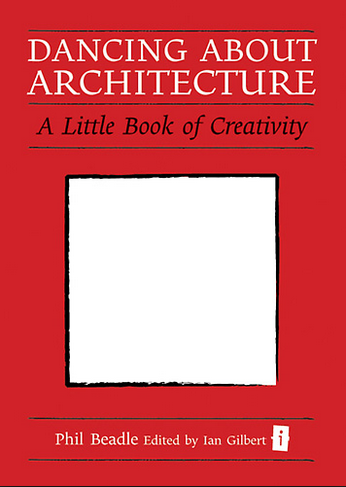This post is part of an ongoing “Wot-I-Got” series. This series acts as a way for me to share Wot-I-Got out of a book or presentation, and to whet your appetite for enquiry. It also forces me to finish books that I start, and to review and summarise my conference notes!
Phil Beadle is an award winning and well respected english teacher from the UK. He has won national teaching and journalism awards and enjoyed widespread critical acclaim. I picked up his recent book, Dancing About Architecture, upon recommendation from a friend who had really enjoyed it. She also directed me to a recent interview with Phil on ABC radio. I’m always keen to hear about how to inspire more creativity in the classroom, so I dove in. 
We were off to a flying start, I couldn’t agree more when Beadle relayed the quote that ‘an idea is nothing more nor less than a new combination of old elements’ and enjoyed his intriguing example (I won’t ruin the surprise) demonstrating the necessity of a stimulus to prompt creativity. As the book progressed Phil offered more and more creativity-promoting ideas that could easily be used in the classroom, the ideas are delivered with with a great whack of humour (even if the tone of writing is lacking a little in modesty) and a superb vocab to boot (great book to read if you want to learn new words!!!). Alas… I have some reservations.
Firstly, many of the ideas hark back to the basic concept that if you throw something random in (eg: have a heap of flash cards in your pocket to stimulate new teaching approaches when you’re getting a bit low on ideas) then you’ll get out an inspiring lesson. Whilst this ‘random assembly’ method does hold some promise, I feel that Phil stretches the technique a bit too far, and too many of his examples stem from this random=creative premise. I was often left wondering whether this approach would achieve the intended educational outcomes (perhaps, performance based outcomes?) but this leads to a question about finding the balance between inspiring students and furnishing them with practical skills for further learning and discovery. This is a balance that warrants further exploration, for me anyway!
Secondly, Phil states that “ A genuinely outstanding teacher will be sufficiently confident in their own abilities to not bother engaging in any real way with the centralised attempt to define what it is they should be doing”. In this quote he is referring to the standardisation and auditing of lesson content and teaching performance such as that undertaken by Ofsted in the UK. Whilst I don’t personally know what sort of a job Ofsted does at ensuring a high quality of teaching and learning, I do believe that standardisation is important. To define a level of accomplishment that is expected from each module or grade is, in my opinion, an excellent initiative. It ensures that students moving between schools (and even countries) have an easier transition, it provides guidelines to help teachers to know how much to cover, and it acts as a yardstick that allows interested parents to keep informed about their child’s education. I believe that “a genuinely outstanding teacher will be sufficiently” aware of the necessity of a cohesive education system so that children aren’t 1: repeating what they did last year and thus getting bored or 2: being asked to take far too big a leap from one grade or teacher to another. The outcomes of such standardisation will be illuminated in the years to come as the effects of the recently implemented Common Core State Standards (U.S.) are studied.
Finally, this book is mostly relevant to English teachers. That’s OK by me, but I’ll let Phils words sum it up:
“The teacher of English respects the importance of the teacher of mathematics…but is acutely aware of the fact that of all subjects on the curriculum only his is capitalised… But he cannot bring himself to care so little about his appearance as to don the clothes the maths teacher wears without question. He also finds the mathematician a tad gauche* socially.” “The teacher of mathematics respects the importance of the teacher of English’s job, but distrusts the impurity of the language they specialise in, cannot understand their clothes and finds them garrulous** socially.”

So Phil, we can agree to disagree on clothing and social etiquette, but we can agree on the importance of creativity in the classroom, and I thank you for your contributions to the topic. This book was well worth the time investment.
*Gauche: unsophisticated and socially awkward.
**Garrulous: excessively talkative, especially on trivial matters… See. Good for the vocab!
Wot-I-Got: Selected notes…location numbers refer to kindle location numbers. The following are (in most part) direct quotes.
Doubt the conventional wisdom unless you can verify it with reason and experiment.-Steve Albini-location 124
We see more of the detail in David when we stand him next to someone else. This is one way in which juxtaposition works. It brings new light to things we might otherwise have made assumptions about. Having a further object to contrast it with allows us to see how it is different to that object.- location 200
‘an idea is nothing more nor less than a new combination of old elements’,and that a person with a propensity to produce ideas will be someone who sees the relationship between things; relationships-location 229
See the obscure pamphlet Literacy through Football Skills by me (Phil)-location 396
If you want to know what can be achieved in a classroom go and see your school’s best teacher of drama. Learn from them. Copy them. Pretend to be them. For in their classes you will see teaching without fear, without stock reliance on the desk, the pencil and the shout. Should every teacher in the country be drama trained?-location 424
Thought-tracking is a drama form where these secret thoughts are voiced, generally by another performer who, it is likely, will be standing behind the performer who is mouthing the platitudes.-location 443
Uncovering truths is a (the) fundamental part of education.-location 453
There are several tips to creating the perfect tableau or frozen picture…. Phil then goes into detail-location 477
Thoughts Aloud-at any point of their choosing, the teacher shouts the word ‘freeze’ and says ‘thoughts aloud’ to which the student voices the exact throughs of their character-location 553
Voices of Conscience- Kids work in threes. One plays the character with the crisis of conscience, the other two play either side of the argument.-location 567
We may then call their names and ask them to offer their ‘thoughts aloud’ for the rest of the class. We might ask them to boil their thoughts into one word. From here we can perform a sound collage. A sound collage is a collection of words that build up to create an aural slab or mass (or mess or wordle).-location 579
much of the modern working world involves and requires skills in presenting to an audience, big or small, and we devote neither time, status nor any particularly skilled professional expertise to teaching kids how to do this.-location 595
We write along to classical music – you don’t? You should – it’s fun. So why not write along to eye music? What work might we get out of the Rothko PowerPoint disco?- location 621
‘Avant-garde music is sort of research music. You’re glad someone’s done it but you don’t necessarily want to listen to it.’-Brian Eno-location 698
Oblique Strategy card, which says something suitably vaporous like: ‘Remove specifics and convert to ambiguities’, a set of cards that you keep somewhere then draw from randomly when you wish to construct a creative lesson-location 702
Ask them why you chose that learning objective.-location 820
it is certainly possible to build a process of thinking that lays fertile ground for these moments. Webb Young, who we met in the first chapter, defines the stages of producing an idea: Gather raw material. Google has made this grazing easy to do. When researching I tend to limit myself to the first two pages that Google throws up. Importantly, the first two pages of images too, as these can throw a whole new light on things, as well as giving material for the dreaded PowerPoint. Always throw in a wild card of the fifty-seventh (or so) page of results. Then go away and digest the information. Take a walk. Come back to it when you feel ready. Look at it from an entirely different angle. Record partial ideas. Riff. Travel up blind alleys. Think about something else. Lie fallow. Let your unconscious do the work. Dream the solution. Cleanse your creative palate. Listen to some very loud music. Play the drums along with it. Involve yourself deeply in something that stimulates you but bears no relation to the task. Rest. The idea appears. You dream the perfect song. Reconcile yourself to failure and stop being a perfectionist. Good enough will do. Find it spindly. Accept it as so. Carve it so that it is good enough. Serve it up.-location 1007